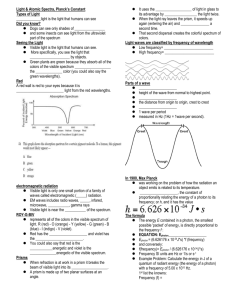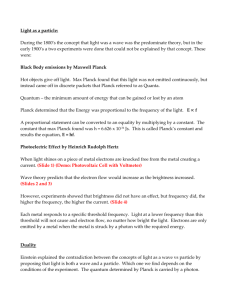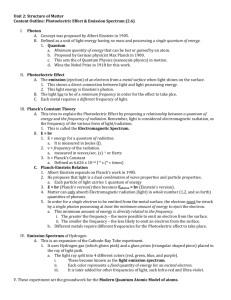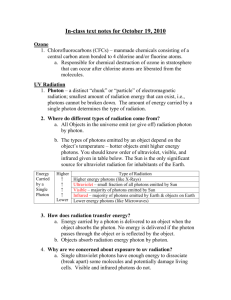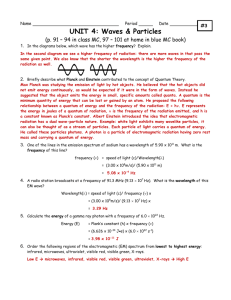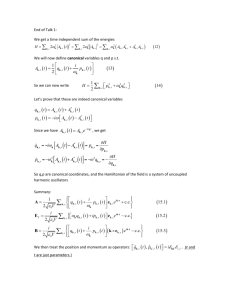Statistical properties of radiation
advertisement
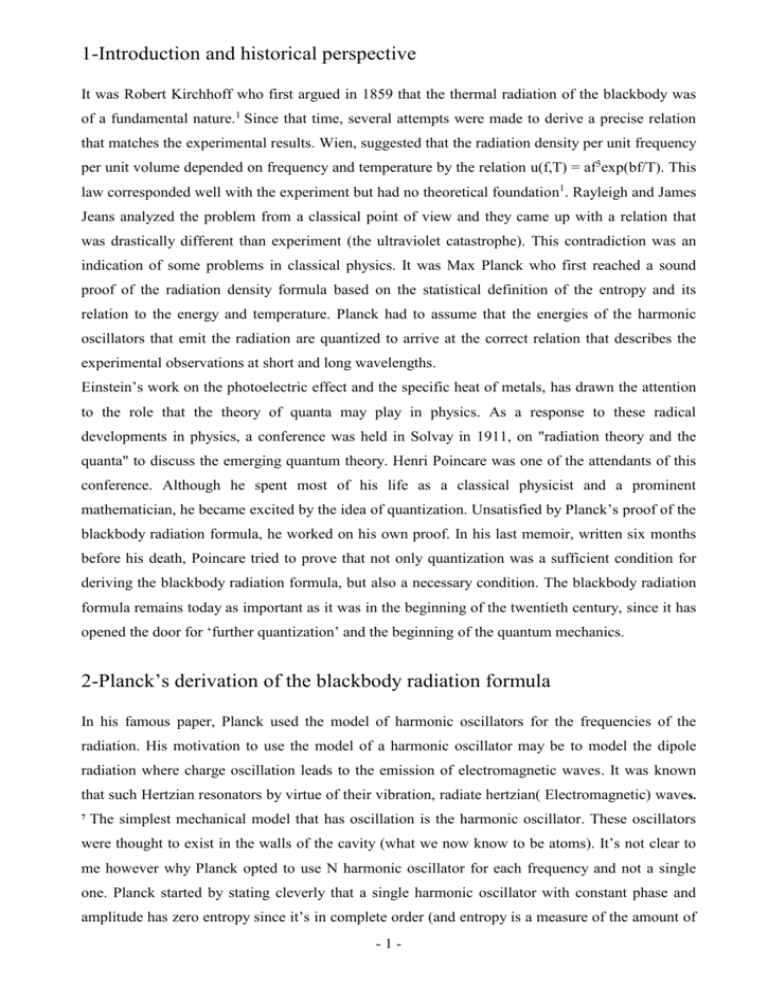
1-Introduction and historical perspective
It was Robert Kirchhoff who first argued in 1859 that the thermal radiation of the blackbody was
of a fundamental nature.1 Since that time, several attempts were made to derive a precise relation
that matches the experimental results. Wien, suggested that the radiation density per unit frequency
per unit volume depended on frequency and temperature by the relation u(f,T) = af3exp(bf/T). This
law corresponded well with the experiment but had no theoretical foundation1. Rayleigh and James
Jeans analyzed the problem from a classical point of view and they came up with a relation that
was drastically different than experiment (the ultraviolet catastrophe). This contradiction was an
indication of some problems in classical physics. It was Max Planck who first reached a sound
proof of the radiation density formula based on the statistical definition of the entropy and its
relation to the energy and temperature. Planck had to assume that the energies of the harmonic
oscillators that emit the radiation are quantized to arrive at the correct relation that describes the
experimental observations at short and long wavelengths.
Einstein’s work on the photoelectric effect and the specific heat of metals, has drawn the attention
to the role that the theory of quanta may play in physics. As a response to these radical
developments in physics, a conference was held in Solvay in 1911, on "radiation theory and the
quanta" to discuss the emerging quantum theory. Henri Poincare was one of the attendants of this
conference. Although he spent most of his life as a classical physicist and a prominent
mathematician, he became excited by the idea of quantization. Unsatisfied by Planck’s proof of the
blackbody radiation formula, he worked on his own proof. In his last memoir, written six months
before his death, Poincare tried to prove that not only quantization was a sufficient condition for
deriving the blackbody radiation formula, but also a necessary condition. The blackbody radiation
formula remains today as important as it was in the beginning of the twentieth century, since it has
opened the door for ‘further quantization’ and the beginning of the quantum mechanics.
2-Planck’s derivation of the blackbody radiation formula
In his famous paper, Planck used the model of harmonic oscillators for the frequencies of the
radiation. His motivation to use the model of a harmonic oscillator may be to model the dipole
radiation where charge oscillation leads to the emission of electromagnetic waves. It was known
that such Hertzian resonators by virtue of their vibration, radiate hertzian( Electromagnetic) waves.
7
The simplest mechanical model that has oscillation is the harmonic oscillator. These oscillators
were thought to exist in the walls of the cavity (what we now know to be atoms). It’s not clear to
me however why Planck opted to use N harmonic oscillator for each frequency and not a single
one. Planck started by stating cleverly that a single harmonic oscillator with constant phase and
amplitude has zero entropy since it’s in complete order (and entropy is a measure of the amount of
-1-
disorder). In his own words, Planck said: “Entropy depends on disorder and this disorder,
according to the electromagnetic theory of radiation for the monochromatic vibrations of a
resonator when situated in a permanent stationary radiation field, depends on the irregularity with
which it constantly changes its amplitude and phase, provided one considers time intervals large
compared to the time of one vibration but small compared to the duration of a measurement. If
amplitude and phase both remained absolutely constant, which means completely homogeneous
vibrations, no entropy could exist and the vibrational energy would have to be completely free to
be converted into work.” However as we will see later at the end of his proof, the single harmonic
oscillator turned out to have a nonzero entropy. To prove his famous relation, Planck had to
quantize the energy of the oscillators and consider many harmonic oscillators instead of only one
and calculate the entropy by counting the number of ways by which the total energy can be
distributed among these oscillators (the number of possible microstates).
By assuming that the energy quantum = ε and the total energy UN=P ε, the number of ways to
distribute P quanta among N distinguishable oscillators is given by:
R
( N P 1)!
P!( N 1)!
Then the enropy directly follows from Boltzmann’s law as SN= k log R
SN = k { (N + P) log (N + P) - N log N - P log P} and in terms of U, ε the entropy can be written
as:
The entropy of a single harmonic oscillator is given by the previous quantity divided by N,
namely:
How did Planck explain the source of the entropy (disorder) in the single oscillator, in contrast to
what he mentioned in the beginning of his article? If he was asked that question after 1927, he may
have said it is due to the uncertainty relation between the two conjugate variable P, Q in the
harmonic oscillator, but what if he was asked in 1900?? How could he reach the same result if he
started by a single harmonic oscillator (i.e., N=1) ??
A direct application of the relation between Temperature, entropy, and Energy of a single
oscillator to the previous equation
1
dS
yields directly
dU
-2-
U
e
k
1
Then as Planck made use of Wien’s law to derive the specific relation between the quantum ε and
the frequency of the oscillator ν. Wien’s law implies that the relation between the energy density u,
and the frequency and temperatures is given by:
Using the relation between the radiation density and the energy of the single oscillator that Planck
8 2
derived in an earlier paper u 3 U , he could rewrite Wien’s law in the form
c
By comparing this relation with the expression for U derived earlier, it’s seen that the energy of the
smallest quantum is given by h , where h is a universal constant.
Combining the previous result and the expression of the radiation density which is the energy per
unit volume per unit frequency interval we obtain the famous Planck law
In the time Planck introduced this assumption of the quantization of the energy of a harmonic
oscillator, nobody noticed how profound this assumption was in the physics. I don’t why didn’t
Planck continue in the same line of thought and ask himself immediately how or why was the
energy of the harmonic oscillator quantized? It was not before 25 years later that the real reason of
quantizing the energy of the harmonic oscillator was rigorously derived from the postulates of
quantum mechanics.
3- Einstein derivation of Planck’s radiation law
Although the famous paper in which Einstein introduced the A, B coefficients was written mainly
to derive the Planck’s radiation law for the blackbody problem, this derivation is usually forgotten
and the paper is remembered only for laying the foundations for the operation of the laser. The
derivation goes as follows:
Einstein assumed that the atoms of the walls of the blackbody are two-level atoms where they can
absorb or emit quanta of energy equal the same amount as the difference between the two levels.
Each atom has an absorption and emission probability Pa, Pe given by
-3-
Where is the density of electromagnetic radiation in the cavity, Ba and Be are undetermined
coefficients for absorption and stimulated emission, respectively, and A is the coefficient for
spontaneous emission.a Let the number of atoms per unit volume in the excited state and ground
state be ne , ng respectively. The detailed balance condition which results from the thermal
equilibrium between the radiation and the atoms states that the probability that an atom in the
ground state gets excited equals the probability that an excited atom emits the photon and decays
to the ground state. This condition can be expressed as:
Then Einstein assumed that the atoms themselves are in thermal equilibrium
b
and he used the
partition function derived from the canonical ensemble to write the ratio between ne and ng as
Solving the four previous equations for
we find that
Which is indeed similar to Planck’s formula. Next, Einstein made use of the results reached by
Rayleigh about the relation between the radiation density and the frequency at long wavelengths
and high temperatures namely
This limit can be indeed satisfied if we choose Ba=Be=B where the radiation density will be in the
form
A / B
kT
. To determine the dependence of A/B and on frequency, Einstein used
another law that states that
has a scaling dependence on the variables υ and T,( Wien’s
displacement law) of the form
To satisfy this equation the only choices for A/B and will be
a
6A.
Einstein, ‘‘Zur Quantentheorie der Strahlung,’’ Phys. Z. 18, 121–128 ~1917
b
The atoms of course are continuously absorbing and emitting photons, but since they are in equilibrium with the
radiation, their total energy is fixed and hence they can be considered as an isolated ensemble.
-4-
Where h, are universal constants. Finally the energy density of the radiation will look like
3
h
e kT 1
We note here that the nonclassical assumption in Einstein derivation is the stationary energy states
of the atom.9
It’s worth mentioning here as we will elaborate in the next derivation that the elements of the
canonical ensemble (which are atoms in our case) have to be able to exchange the quanta of energy
between each other. This is done in our case by atoms emitting photons that are absorbed by other
atoms. We note also that the atoms were assumed to have two level only while the fact that the
spectrum of the blackbody radiation is continuous in frequency necessitates that all frequency
resonances have to be present in the atoms of the wall and not only a discrete set of them. I think
this problem is resolved by the presence of broadening mechanisms that leads eventually to the
continuous spectrum. But shouldn’t the different intensities of different lines affect the radiation
spectrum of the blackbody?
4-Third derivation using Bose-Einstein statistics
A third derivation in which Pathria in his book attributed to Einstein, uses the Bose-Einstein
statistics for the grand canonical ensemble. Here the radiation in the cavity is treated as a gas of
indistinguishable photons obeying Bose statistics, namely the expectation number of the photons
occupying a certain energy level ε is given by n
1
e
/ kT
1
. However several comments are in
order here. First, the postulate of equal apriori probabilities implies that the system will be in the
macrostate (e.g, E) that has the largest number of microstates. This is based on the assumption that
at the same macrostate, the system can jump freely between different allowed microstates without
restriction. For the case of ideal gas, these microstates may correspond to different energy
distributions between the particles (or different space configurations). This of course requires a
means of energy transfer between the particles which truly exists in the ideal gas through
collisions. But what about the system of bosonic photons we have here? How can the system jump
from one microstate to another and how can the photons exchange energy with one another?c As
for the chemical potential, Pathria set it to zero. He said that because the number of photons is
indefinite since photons are being absorbed and emitted from the walls continously, but isn't this
the case for the grand canonical ensemble? Moreover I expect that at equilibrium the number of
photons is fixed and not indefinite as Pathria stated, and hence we should use the canonical
distribution rather than the grand canonical. However regardless of the type of the ensemble we
c
Let alone other systems we studied in the course like a system of magnetic dipoles for example.
-5-
use, the most probable value for n calculated without referring to a certain ensemble has the same
value as n . But still I couldn’t find a satisfactory explanation of setting the chemical potential
of photons to zero. Next steps in this derivations are to calculate the density of states g ( )d . In
terms of the phase space g ( )d 2
dq 3 4p 2 dp
where the factor 2 is used to account for two
h3
perpendicular directions of polarizations of the photon spin. Using the relation between momentum
V
and frequency p
we find that g ( )d 2 3
c
h
2
d
V 2 d
2 3 d By expressing
4
c
c c
the energy level ε
as we get exactly the same relation of the radiation density as that of Planck.
It’s interesting that the assumption of the quantized nature of radiation inside the cavity (that light
waves are made up of particles called photons) is sufficient to impose the quantized energy levels
on atoms in equilibrium with light.
5- Poincaré's last memoir on the quantum discontinuity of nature
Here I’m going to comment on another proof of the quantum nature of light initiated by the famous
French mathematician and physicist Henri Poincare. Since Poincare spent most of his life as a
certified master of classical physics one would expect that he would be very reluctant at the age of
57 to change his mind about the nature of continuity of matter and radiation. However upon
attending the Solvay conference that was held specially to investigate the new ideas of the
quantum nature of light and to shed more light on the blackbody radiation, the “most mysterious
phenomenon and a most difficult one to unveil” he was very enthusiastic upon the new idea and
actively participated on the discussions. After the conference, Poincare returned to Paris and
became engaged with the quantum problem. In accord to my objection to the third proof given
above, Poincare considered Planck’s proof lacking a very important component, the mechanism to
achieve equilibrium between in the system of harmonic oscillators. In his own words, Poincare
wrote: “For a (equilibrium) distribution to take place between the resonators of different
wavelengths whose oscillations are the cause of radiation, the resonators must be capable of
exchanging their energy. Otherwise, the initial distribution will persist indefinitely and this initial
distribution is arbitrary, there could be no unique law of radiation.”
However, I don’t agree with that since Planck had to assume only that harmonic oscillators of the
same frequency are in equilibrium. . In this case energy can be transferred between them without
any problem since they are in resonance with one another There is no need to find a mechanism for
exchanging energy between oscillators of different frequencies. To provide this mechanism,
d
Pathria,7.2.6
-6-
Poincare modeled the interaction between harmonic oscillators as mediated by a medium of freely
moving atoms which collide with the resonators; is this a physical model? Using “inverse
statistical mechanics”, Poincare proved that the hypothesis of quanta is a sufficient and necessary
condition to account for Planck’s law of radiation. As I remember, in part of his proof, Poincare
used the partition function as Fourier transform of the radiation distribution.
6- Quantum statistics of photons
In this part I’m going to illustrate some concepts in the quantum theory of radiation that will be
useful in subsequent sections. The quantum first order degree of coherence which identifies the
degree of correlation between the light fields at two space time points (r1,t1) and (r2,t2) is defined
by
g (r1t1, r2 t 2 )
(1)
E (r1t1 ) E (r2 t 2 )
E
(r1t1 ) E (r1t1 ) E (r2 t 2 ) E (r2 t 2 )
1
2
Where E (r1t1 ), E (r2 t 2 ) are the electric field operators. The subscripts designating a certain mode
and polarization of the field have been omitted to simplify notation. A fuller representation of the
electric field operator is given by
Ek , (r , t ) E k , (r , t ) E k , (r , t )
C aˆk , exp( it ik .r ) aˆ k , exp( it ik .r )
The expectation values are calculated using the density operator,
E (r1t1 ) E (r1t1 ) Tr E (r1t1 ) E (r1t1 )
The quantity g (1) (r1t1, r2t 2 ) signifies the ability of the light at the two space time points to form
interference fringes when superimposed. By expanding the expressions of the field operator, it can
r1 r2
be seen that the coherence function is a function of the parameter t 2 t1
, hence it can be
c
written for short as g (1) ( ) . First order coherence has similar properties in classical and quantum
representations of light. g (1) ( ) has the same numerical range in both schemes, namely
1 g (1) ( ) 0 . The interference pattern which is a result of the first order coherence can be
obtained using both treatments. However more striking differences occur in measurements that
depend on second order coherence.3
In a similar way the quantum degree of second order coherence is defined as
E
(
r
t
)
E
(
r
t
)
E
(
r
t
)
E
(r2t2 )
11
2 2
11
g ( 2) (r1t1, r2t2 ; r2t2, r1t1 )
E (r1t1 ) E (r1t1 ) E (r2t2 ) E (r2t2 )
-7-
The second order coherence defines the correlation between the light intensities in two different
space time points. With intensities measured by phototubes, the correlation is proportional to the
transition rate of the joint absorption of photons at the two space time points.3 Note that the
sequence of operators matters in this definition, i.e, annihilation operators to the left. The second
order coherence can be measured in a photon beam at the same location using a single photon
detector by counting the numbers of photons registered by the detector in brief in two brief
intervals separated by time , then the second order coherence is given by the correlation between
the photon numbers as g ( 2) ( ) n(0)n( ) / n 2
7-Thermal (chaotic) photon states
Since photons are bosons, they follow Bose-Einstein statistics and the probability of occupying the
mode of energy ε is given by (See Pathria 6.4.10)
P (n)
e
n
1 e
, and since the mean number of photons <n> is given by n
1
, then
e 1
The probability to detect n photons in a small time τ , P(n) can be written as
P ( n)
n
n
1 n
n 1
Hence, the density operator of a single mode of thermal (blackbody) radiation is described by
1
Where n (n!) 2 (a ) n 0 and n is the mean number of photons detected in a certain time (τ)
and is given by
n is the number state of a single mode and Z is the partition function given by :
The variance of the photon number in thermal states is given by
-8-
8-Photon statistics of a coherent source
A coherent source emits photons in states of a coherent superposition of number states in the form
where α in general is a complex number. Laser beams are best characterized by these states since
they have the minimum amount of uncertainty in the phase and amplitude. The mean number of
photons in the coherent states n is given by the relation
and the probability to detect n
photons P(n) is
We notice that this is a Poissonian distribution. We remember that this distribution is characteristic
of processes involving the occurrence of discrete events happening independent of each other.
Thus, in a coherent state photons behave like they were uncorrelated classical objects! In contrast
to naive expectations, the photons in a (single mode) laser (and well above the threshold) arrive in
a random fashion; in particular they do not “ride” on the electrical field maxima.8 The counting
statistics are the same as the statistics of telephone calls arriving at a switchboard or web pages
requests from a web server.
As in possonian distribution, the variance of the number of detected photons n is given by the
relation n n . A coherent state of radiation is first order coherent, that is g (1) ( ) 1 for all
2
pairs of space time points. A comparison between the photo-count distribution of the thermal
(chaotic) light and the coherent light is illustrated in figure(1)
Figure 1
The photo-count distribution in this graph is obtained experimentally by letting the light fall on a
photo-detector through a shutter that is open for a very short interval and counting the number of
photons registered by the photo-detector. This measurement is repeated many times and a time
-9-
delay is allowed between successive measurements. This delay should be long compared to the
coherent time of the light.
It’s interesting to note that the photon count distribution of both coherent and chaotic light can also
be obtained from other arguments as Loudon did in 6.6, 6.7 in his book. The only assumption
made are that the number of photons detected by the photodetctor is proportional to the intensity of
the light, and another assumption pertinent to the type of radiation. For coherent radiation the other
assumption is that the intensity of light is independent of time, while for chaotic light the intensity
has a Gaussian distribution and the averaging process over time is equivalent to the ensemble
averging by the ergodicity theorem. The derivation is lengthy and can be reviewed from Loudon’s
book.
It’s worth mentioning that thermal photon statistics can be obtained by a superposition of many
coherent states in which α changes randomly in Gaussian distribution given by
And hence the density operator will be given by
Where n is given by
A comparison between the distribution of α in the coherent (laser) source and the thermal source is
shown in figure(2)
Figure 2
Another important aspect in the comparison between chaotic light and laser is the bunching effect.
Photon bunching is the tendency of photons to group together in bunches, if the photodetctor
detected n photons in a certain interval, it’s more probable that these n photons reached the
photodetector close to each other than spread in time.
- 10 -
As shown in figure (3), chaotic light has strong correlation g ( 2) ( ) at shorter times that decreases
as increases, while the photons of the laser beam arrive at the photodetector uncorrelated-as
mentioned before- and exhibits no bunching.
Figure 3
9- Non-classical properties of light
Now we turn our attention to two other distributions of light that are manifestations of certain
nonclassical states of light, namely photon anti-bunching and sub-poissonian photon statistics.
Anti-bunching is the opposite effect of bunching i.e., “the photons prefer to come not too close.” In
a quantitative manner, photon anti-bunching occurs of the second order coherence increases from
its initial value at 0 11 or equivalently
Another criterion for photon anti-bunching is 1 g ( 2) (0) 0
Histogram of time delays between consecutive photon pairs in photon anti-bunched beam is shown
in figure(4). It’s shown clearly that there is a dip in the correlation function at zero delay indicating
an anti-correlation between photons.
- 11 -
Figure 4
The phenomenon of anti-bunching or anti-correlation is used as an evidence for the quantum
nature of radiation in some experiments in an experiment of the Hanbury-Brown Twiss type. As shown
in figure(5)
a light beam is let to pass through a biprism. The two beams, leaving the prism are
detected using an avalanche photodetctor and the output of the light beams are correlated (i.e, the
number of coincednces is calculated). “If light is really made of quanta, a single photon should
either be deviated upwards or downwards, but should not be split by the biprism. In that case, no
coincidences corresponding to joint photodetections on the two output beams should be observed.
On the opposite, for a semiclassical model that describes light as a classical wave, the input
wavefront will be split in two equal parts, leading to a non-zero probability of joint detection on
the two photodetectors. Observation of zero coincidences, corresponding to an anticorrelation
effet, would thus give evidence for a particle-like behaviour.” e
Figure 5
e
For an experiment by a group in L'ECOLE NORMALE SUPERIEURE DE CACHAN, See
http://www.physique.ens-cachan.fr/franges_photon/anticorrelation.htm
- 12 -
Unlike Poissonian photon statistics, sub-Poisson photon statistics is a photon number distribution
for which the variance is less than the mean and super-Poisson statistics is a photon number
distribution for which the variance is greater than the mean. It has been shown by Mandel and Zou
10
that these two nonclassical phenomena are not related and needn’t occur together as it was
thought previously by some authors.
10-Conclusion
Different derivation have been introduced for the Planck’s radiation formula of the blackbody
radiation, the first quantum mechanical relation. The quantization of the electromagnetic energy,
had the profound impact to quantize many other quantities and give birth to the field of quantum
mechanics. The quantum aspects of radiation lead to phenomena distinct from the classical picture,
i.e., photon anti-bunching. The statistical properties of photons have many application. I found
one a physicist whose research interests are mainly the application of quantum optics in
cosmology. The quantum statistical properties of light had such an impact that led Roy J. Glauber
in his Nobel lecture state that “Quantum Optics=Photon Statistics”.
11-References
1234-
Max Planck: the reluctant revolutionary, Helge Kragh, Physics World, December 2000.
100 Years of Light Quanta, Roy J. Glauber, Nobel Lecture
The Quantum Theory of Light, 2nd edition, Roudney Loudon.
On the Law of Distribution of Energy in the Normal Spectrum, Max Planck Annalen der
Physik
vol. 4, p. 553 ff (1901)
5- The evolution of radiation toward thermal equilibrium: A soluble model that illustrates the
foundations of statistical mechanics, Michael Nauenberg, Am. J. Phys. 72 ~3!, March 2004
6- Statistical Mechanics, 2nd edition, Pathria
7- Poincaré's proof of the quantum discontinuity of nature Jeffrey J. Prentis Am. J. Phys. 63,
339 (1995)
8- Photons and Photon Statistics: From Incandescent Light to Lasers, Ralph v. Baltz
9- Einstein’s derivation of Planck’s radiation law, Henry R. Lewis, Am. J. Phys. 41, January
1973
10- Photon-antibunching and sub-Poissonian photon statistics, X. T. Zou and L. Mandel, Phys.
Rev. A 41, 475 - 476
11- Various Approaches to photon AntiBunching in Second Harmonic generation, A.
Miranowicz et.al
12- http://www.stanford.edu/group/moerner/QD.html
13- On the Law of Distribution of Energy in the Normal Spectrum Max Planck, Annalen der
Physik vol. 4, p. 553 ff (1901)
- 13 -
- 14 -

